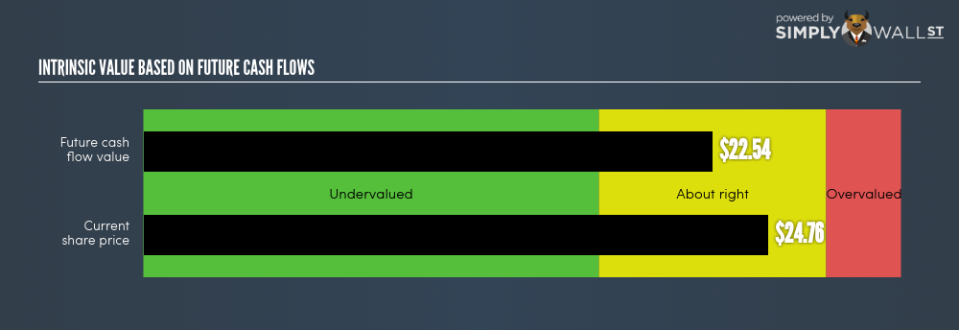Is Civista Bancshares Inc (NASDAQ:CIVB) Expensive For A Reason? A Look At The Intrinsic Value

One of the most difficult industry to value is banking, given that they adhere to different rules compared to other companies. For example, banks are required to hold more capital to reduce the risk to depositors. Emphasizing line items like book values, along with the return and cost of equity, is appropriate for estimating CIVB’s intrinsic value. Today I’ll take you through how to value CIVB in a relatively effective and uncomplicated way. View out our latest analysis for Civista Bancshares
What Is The Excess Return Model?
Before we begin, remember that financial stocks differ in terms of regulation and balance sheet composition. CIVB operates in United States which has stringent financial regulations. In addition to this, banks generally don’t have significant amounts of tangible assets on their books. The Excess Returns model overcomes the required capital kept on hand and lack of tangibles by focusing on forecasting stable earnings, rather than less relevant factors such as depreciation and capex, which more traditional models focus on.
The Calculation
The main assumption for Excess Returns is, the value of the company is how much money it can generate from its current level of equity capital, in excess of the cost of that capital. The returns above the cost of equity is known as excess returns:
Excess Return Per Share = (Stable Return On Equity – Cost Of Equity) (Book Value Of Equity Per Share)
= (10.86% – 9.96%) x $19.97 = $0.18
We use this value to calculate the terminal value of the company, which is how much we expect the company to continue to earn every year, forever. This is a common component of discounted cash flow models:
Terminal Value Per Share = Excess Return Per Share / (Cost of Equity – Expected Growth Rate)
= $0.18 / (9.96% – 2.95%) = $2.57
These factors are combined to calculate the true value of CIVB’s stock:
Value Per Share = Book Value of Equity Per Share + Terminal Value Per Share
= $19.97 + $2.57 = $22.54
This results in an intrinsic value of $22.54. Given CIVB’s current share price of US$24.76, CIVB is , at this time, priced in-line with its intrinsic value. Therefore, there’s a bit of a downside if you were to buy CIVB today. Valuation is only one side of the coin when you’re looking to invest, or sell, CIVB. Fundamental factors are key to determining if CIVB fits with the rest of your portfolio holdings.
Next Steps:
For banks, there are three key aspects you should look at:
Financial health: Does it have a healthy balance sheet? Take a look at our free bank analysis with six simple checks on things like bad loans and customer deposits.
Future earnings: What does the market think of CIVB going forward? Our analyst growth expectation chart helps visualize CIVB’s growth potential over the upcoming years.
Dividends: Most people buy financial stocks for their healthy and stable dividends. Check out whether CIVB is a dividend Rockstar with our historical and future dividend analysis.
For more details and sources, take a look at our full calculation on CIVB here.
To help readers see pass the short term volatility of the financial market, we aim to bring you a long-term focused research analysis purely driven by fundamental data. Note that our analysis does not factor in the latest price sensitive company announcements.
The author is an independent contributor and at the time of publication had no position in the stocks mentioned.

 Yahoo Finance
Yahoo Finance 
